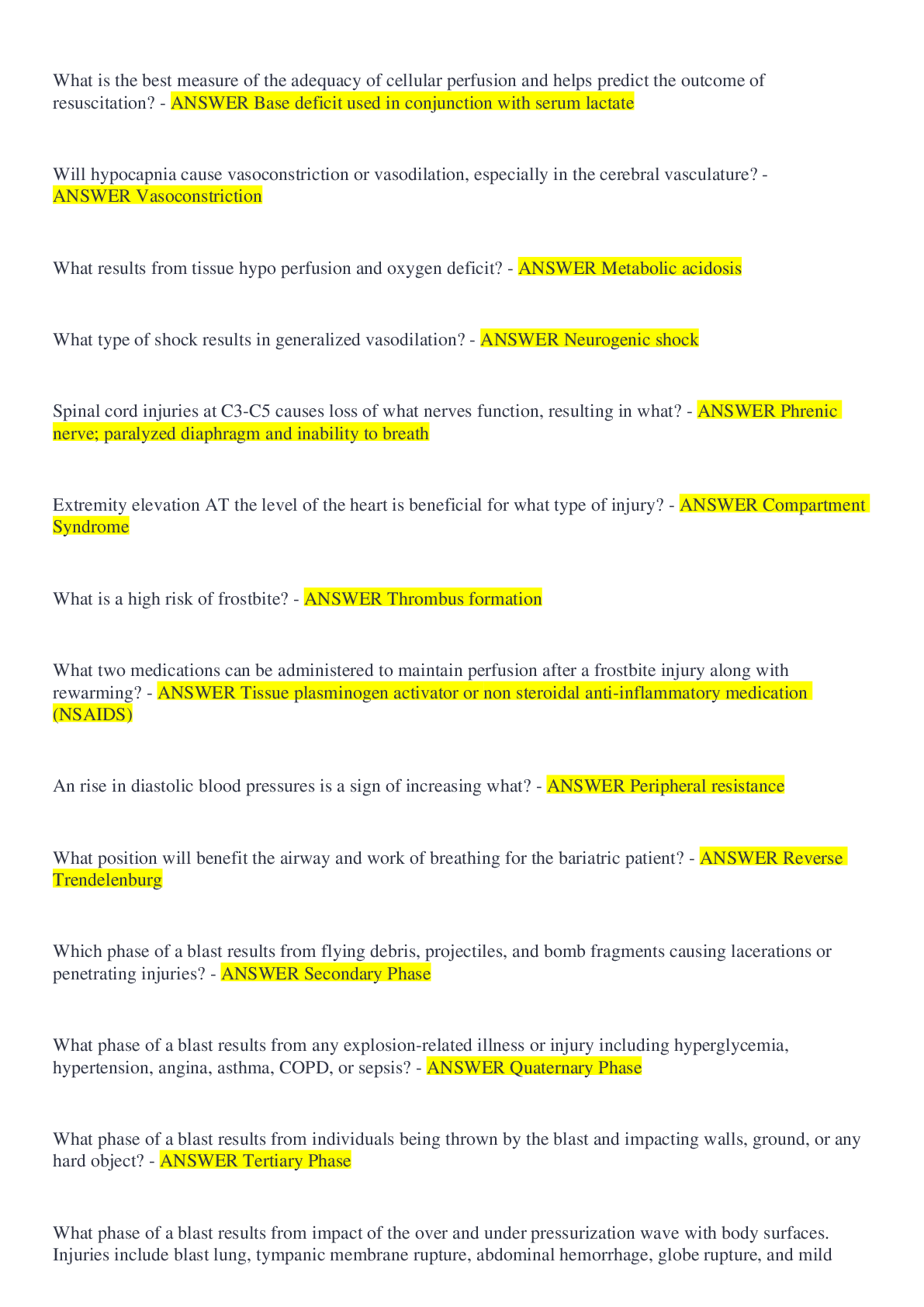Health Care > EXAM > EKG Final Exam 2022 questions with answers (100% correct) (All)
EKG Final Exam 2022 questions with answers (100% correct)
Document Content and Description Below
EKG Final Exam 2022 questions with answers (100% correct) A branch of the _______ supplies the right atrium and right ventricle with blood Correct Answer: right coronary artery (RCA) Stimulatio... n of parasympathetic nerve fibers typically results in what action? Correct Answer: Slowed conduction through the atrioventricular (AV) node The contribution of blood that is added to the ventricles and results from atrial contraction is called: Correct Answer: atrial kick Semilunar Valves include: Correct Answer: pulmonary valve and aortic valve The left main coronary artery divides into the Correct Answer: LAD and Cx branches _____ cells are specialized cells of the electrical conduction system responsible for the spontaneous generation and conduction of electrical impulses. Correct Answer: Pacemaker The absolute refractory period beings with.... Correct Answer: begins with the onset of the QRS complex and terminates at approximately the apex of the T wave T/F: The QT interval represents the time from initial depolarization of the ventricles to the end of ventricular repolarization Correct Answer: true How do you determine whether the atrial rhythm on an ECG tracing is regular or irregular? Correct Answer: compare P-P intervals Which ECG leads use two distinct electrodes, one of which is positive and the other negative? Correct Answer: leads I, II, and III In sinus arrhythmia, a gradual decreasing of the heart rate is usually associated with? Correct Answer: expiration An ECG rhythm strip shows a ventricular rate of 46 bpm, a regular rhythm, a PR interval of 0.14 second, a QRS duration of 0.06 second, and one upright P wave before each QRS. This rhythm is: Correct Answer: sinus bradycardia SA block is a disorder of ______, and sinus arrest is a disorder of impulse _______. Correct Answer: SA block is a disorder of conduction Sinus arrest is a disorder of formation Signs and symptoms experienced during a tachydysrhythmia are usually primarily related to: Correct Answer: decreased ventricular filling time and stroke volume Example that reflects ectopic (latent) pacemaker: Correct Answer: the AV junction and ventricles A wandering atrial pacemaker rhythm with a ventricular rate of 60 to 100 bpm may also be referred to as: Correct Answer: multiform atrial rhythm The most common type of supraventricular tachycardia (SVT) is? Correct Answer: AVNRT-- AV nodal reentrant tachycardia If the onset or end of paroxysmal atrial tachycardia or paroxysmal supraventricular tachycardia (PVST) is not observed on the ECG, the dysrhythmia is called: Correct Answer: SVT paroxysmal means sudden onset Most common sustained dysrhythmia in adults? Correct Answer: AFib T/F: The difference between premature atrial complexes (PACs) and premature junctional complexes (PJCs) in leads II, III and aVF is a PAC typically has a positive P wave before the QRS complex, whereas a P wave may or may not be present in a PJC Correct Answer: true A Wolff-Parkinson-White (WPW) pattern is associated with a : Correct Answer: short PR interval, delta wave, and wide QRS complex What is the main difference between atrial flutter and other atrial dysrhythmias? Correct Answer: Atrial flutter has the saw-tooth or picket-fence appearance of waveforms before the QRS When a junctional rhythm is viewed in lead II, where is the location of the P wave on the ECG if atrial and ventricular depolarization occur simultaneously? Correct Answer: during (within) the QRS complex The usual rate of nonparoxysmal junctional tachycardia is: Correct Answer: 101-140 bpm Junctional (or ventricular) complexes may come early (before the next expected sinus beat) or late (after the next expected sinus beat). If the complex is early, it is called ________ If the complex is late, it is called _________ Correct Answer: early = premature complex late = escape beat Depending on the severity of the patient's signs and symptoms, management of slow rhythms may require therapeutic intervention including: Correct Answer: administration of ATROPINE Atropine speeds the heart rate up The term for THREE or MORE premature ventricular complexes (PVCs) occurring in a row at a rate of more than 100 bpm is: Correct Answer: A run of VT PVCs that look ALIKE in the same lead and begin from the same anatomic site (i.e., focus) are called _____________ PVCs Correct Answer: uniform Which dysrhythmias has QRS complexes that vary in shape and amplitude from beat to beat and appear to twist from upright to negative or negative to upright and back, resembling a spindle? Correct Answer: PMVT---polymorphic VT When a delay or interruption in impulse conduction from the atria to the ventricles occurs as a result of a transient or permanent anatomic or functional impairment, the resulting dysrhythmia is called a: Correct Answer: AV block Whenever the criteria for BBB have been met in lead V1 displays an rSR` pattern, you should suspect a: Correct Answer: RBBB---right bundle branch block A _______ BBB produces an rSR` pattern in lead V1 Correct Answer: Right A ________ BBB produces a QS pattern in lead V1 Correct Answer: Left T/F: The PR interval of a first-degree AV block is constant and more than 0.20 second in duration Correct Answer: true T/F: A complete AV block is a third-degree AV block Correct Answer: true T/F: During a 2:1 AV block, the PR interval is constant Correct Answer: true Which lead is the best to use when differentiating between RBBB & LBBB? Correct Answer: V1 The term capture, as it pertains to pacing, refers to: Correct Answer: the successful conduction of an artificial pacemaker's impulse through the myocardium, resulting in depolarization The 12-lead ECG only provides a __________ - second view of each lead Correct Answer: 2.5 second Although a right ventricular infarction may occur by itself, it is more commonly associated with a(n) _____ wall myocardial infarction (MI). Correct Answer: inferior "Poor R-wave progression" is a phrase used to describe R waves that decrease in size from V1 to V4. This is often seen in a(n) _____ infarction. Correct Answer: anteroseptal The left atrium receives blood form the _________ Correct Answer: pulmonary veins The apex of the heart is formed by the ________ Correct Answer: Tip of the left ventricle The anterior surface of the heart consists primarily of the ________ Correct Answer: right ventricle Which side of the heart is a low-pressure system that pumps venous blood to the lungs? Correct Answer: right Which side of the heart is a high-pressure system that pumps arterial blood to the systemic circulation? Correct Answer: left Complete occlusion of the ________ coronary artery, also referred to as the widow maker, usually results in sudden death Correct Answer: left main The left main coronary artery divides into the __________ branches Correct Answer: anterior inter ventricular artery descending and circumflex Blood flows from the left atrium through the _________ valve into the left ventricle Correct Answer: mitral valve Thin strings of fibrous connective tissue extend form the AV valves to the papillary muscles and prevent the AV valves from bulging back into the atria during ventricular systole. These strands are called: Correct Answer: chordae tendineae The normal pacemaker of the heart is the _______ node, which is found in the _______ atrium, and has an intrinsic firing rate of _______ bpm Correct Answer: SA node is the pacemaker of the heart SA node is located in the right atrium SA fires at a rate of 60-100 bpm On an ECG, the first negative deflection seen after the P wave is? Correct Answer: the Q wave Lead II records the difference in electrical potential between the ______ leg and the _______ arm Correct Answer: Left leg and right arm Lead II, III, and aVF view the _____ surface of the left ventricle Correct Answer: inferior What does the QRS complex represent in the ECG wave tracing? Correct Answer: ventricular depolarization Leads I, aVL, V5, and V6 view the _____ surface of the left ventricle. Correct Answer: lateral surface The absolute refractory period begins with the onset of the _______ and terminates ______ Correct Answer: QRS complex; terminates at the apex of the T wave On the ECG, the T wave represents ________ Correct Answer: ventricular repolarization What is the first positive deflection seen on the ECG after the P wave? Correct Answer: R wave _____ cells are working cells of the heart that contain contractile filaments and form the muscular layer of the atrial walls and the thicker muscular layer of the ventricular walls.: Correct Answer: myocardial When cardiac muscle cell is stimulated, the cell is said to _________ Correct Answer: depolarize On the ECG, the P wave represents atrial _______ and the QRS complex represents ventricular __________ Correct Answer: P wave = atrial depolarization QRS complex = ventricular depolarization Tall, peaked T waves observed on the ECG are most commonly seen in patients with? Correct Answer: hyperkalemia In sinus arrhythmia, a gradual increasing of the heart rate is usually associated with ________ Correct Answer: inspiration (breathing in) Management of a patient with a sinus tachycardia might include: Correct Answer: identification and treatment of the underlying cause Possible causes of sinus bradycardia: Correct Answer: inferior MI, prolonged standing, increased intracranial pressure, beta-blocker overdose The intrinsic rate of the AV bundle is _________ bpm Correct Answer: 40-60 bpm The term controlled atrial fibrillation means: Correct Answer: the overall ventricular rate is less than 100 bpm Atrial Fibrillation is characterized by: Correct Answer: An erratic, wavy baseline and irregular ventricular rhythm. What best describes multifocal atrial tachycardia? Correct Answer: atrial and ventricular rhythms are irregular How are frequent PACs usually managed? Correct Answer: Correcting the underlying cause (also reducing stress, reducing/eliminating stimulants, treat heart failure) Leads V4R, V5R and V6R are used to measure: Correct Answer: right ventricle A wandering atrial pacemaker rhythm with a ventricular rate of 60-100 bpm may also be referred to as ___________ Correct Answer: multiform atrial rhythm To determine whether the ventricular rhythm on an ECG tracing is regular or irregular, compare the ________ intervals Correct Answer: R-R Delivery of an electrical current timed for delivery during the QRS complex is called ______ Correct Answer: synchronized cardio version Sometimes, when a PAC occurs very prematurely and close to the T wave of the preceding beat, only a P wave may be seen with no QRS after it (appearing as a pause). This type of PAC is termed a ______ PAC Correct Answer: nonconducted, blocked PAC PACs associated with a wide QRS complex are called Correct Answer: aberrantly conducted PACs An accessory pathway that has one end attached to normal conductive tissue is called a(n) _____ _____. Correct Answer: Bypass tract [Show More]
Last updated: 1 year ago
Preview 1 out of 12 pages
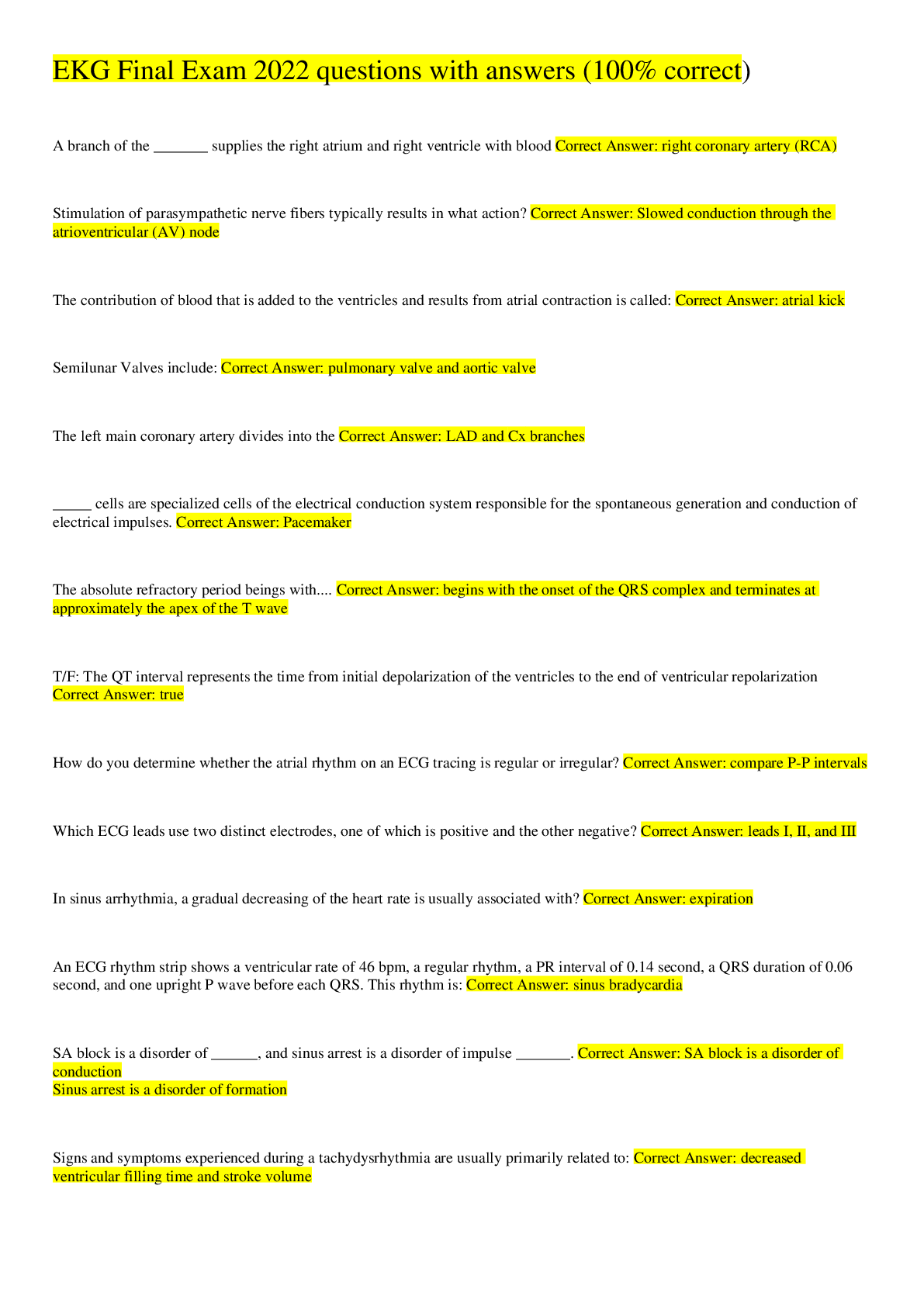
Reviews( 0 )
Document information
Connected school, study & course
About the document
Uploaded On
Aug 12, 2022
Number of pages
12
Written in
Additional information
This document has been written for:
Uploaded
Aug 12, 2022
Downloads
0
Views
38


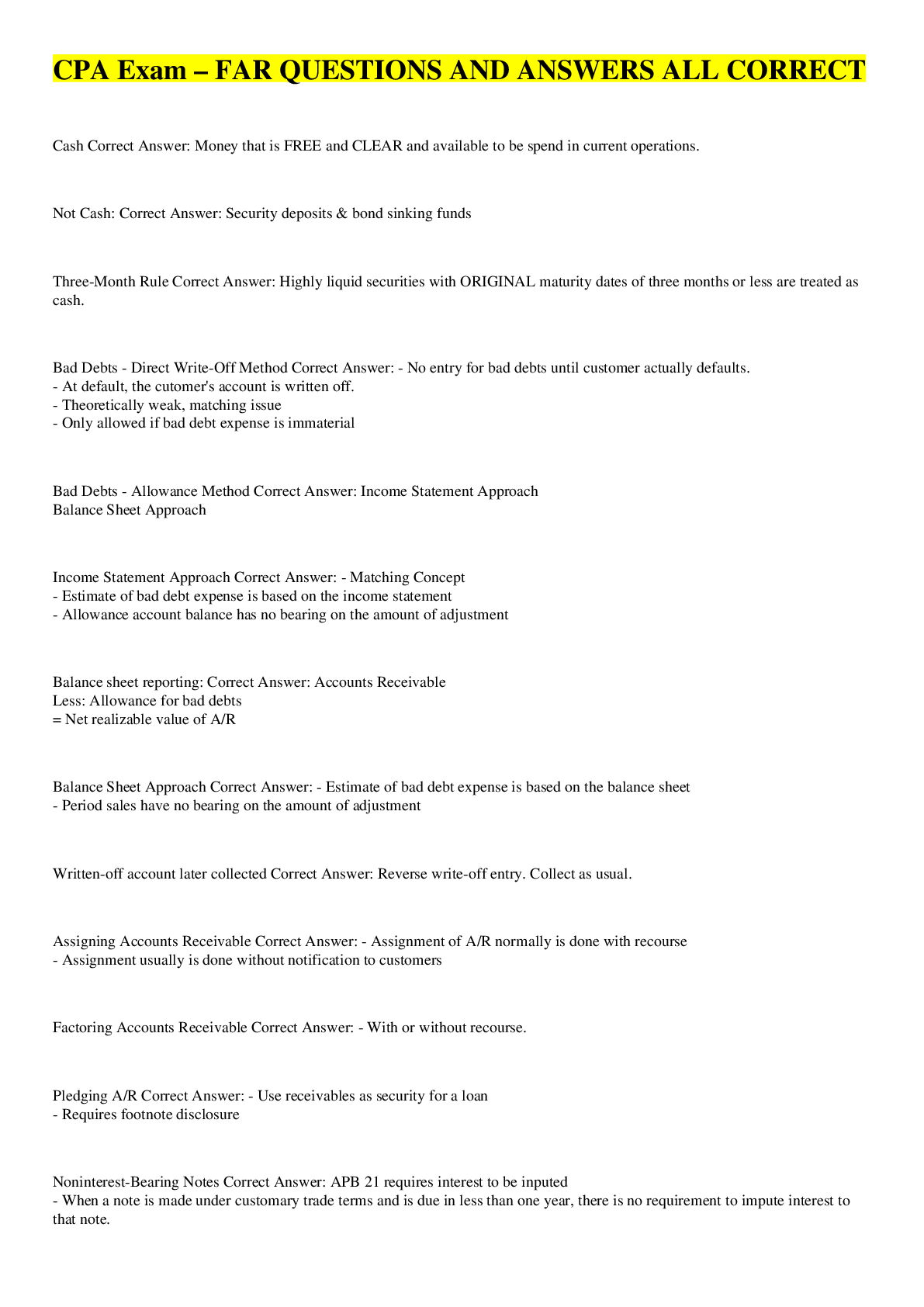
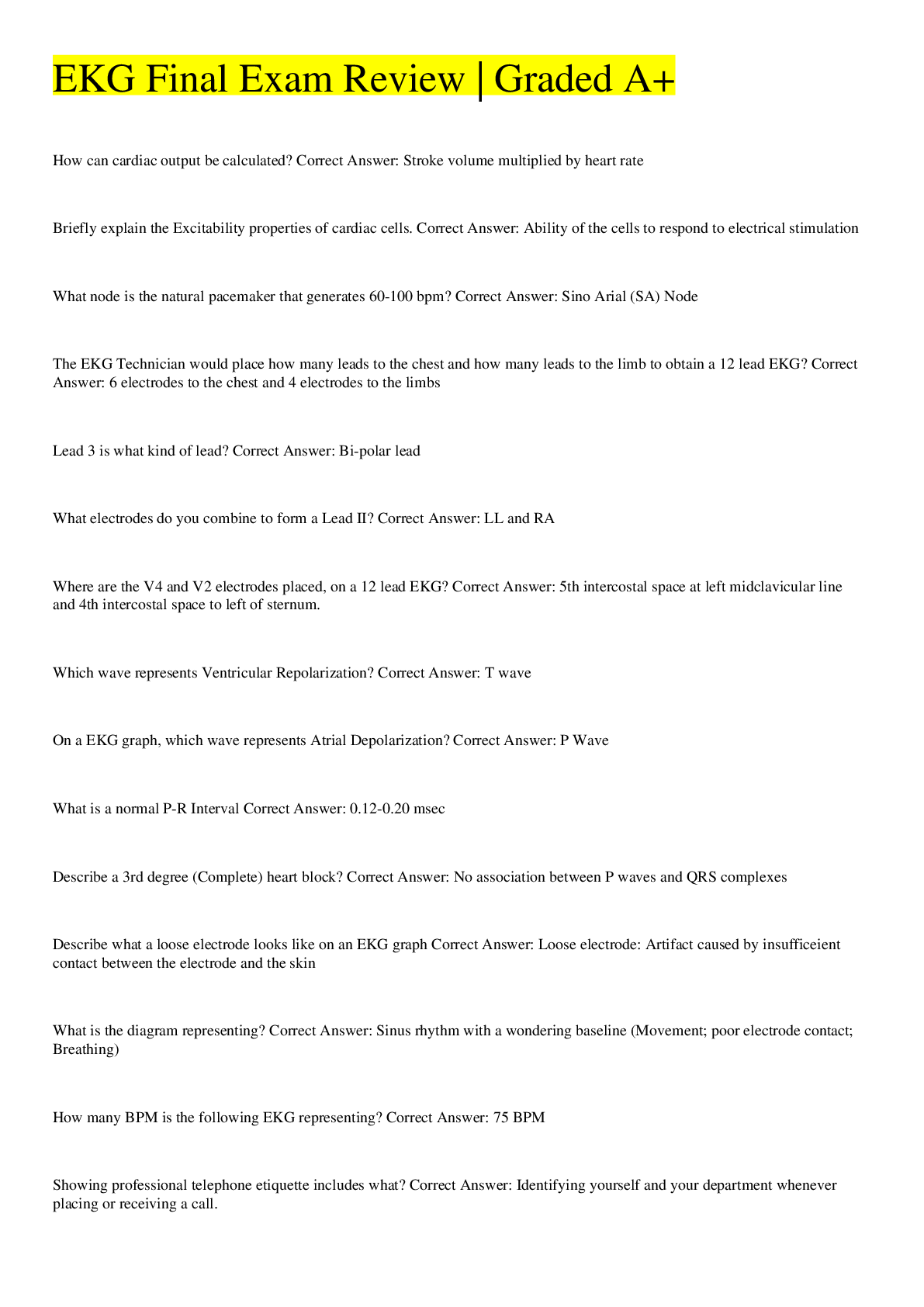
.png)


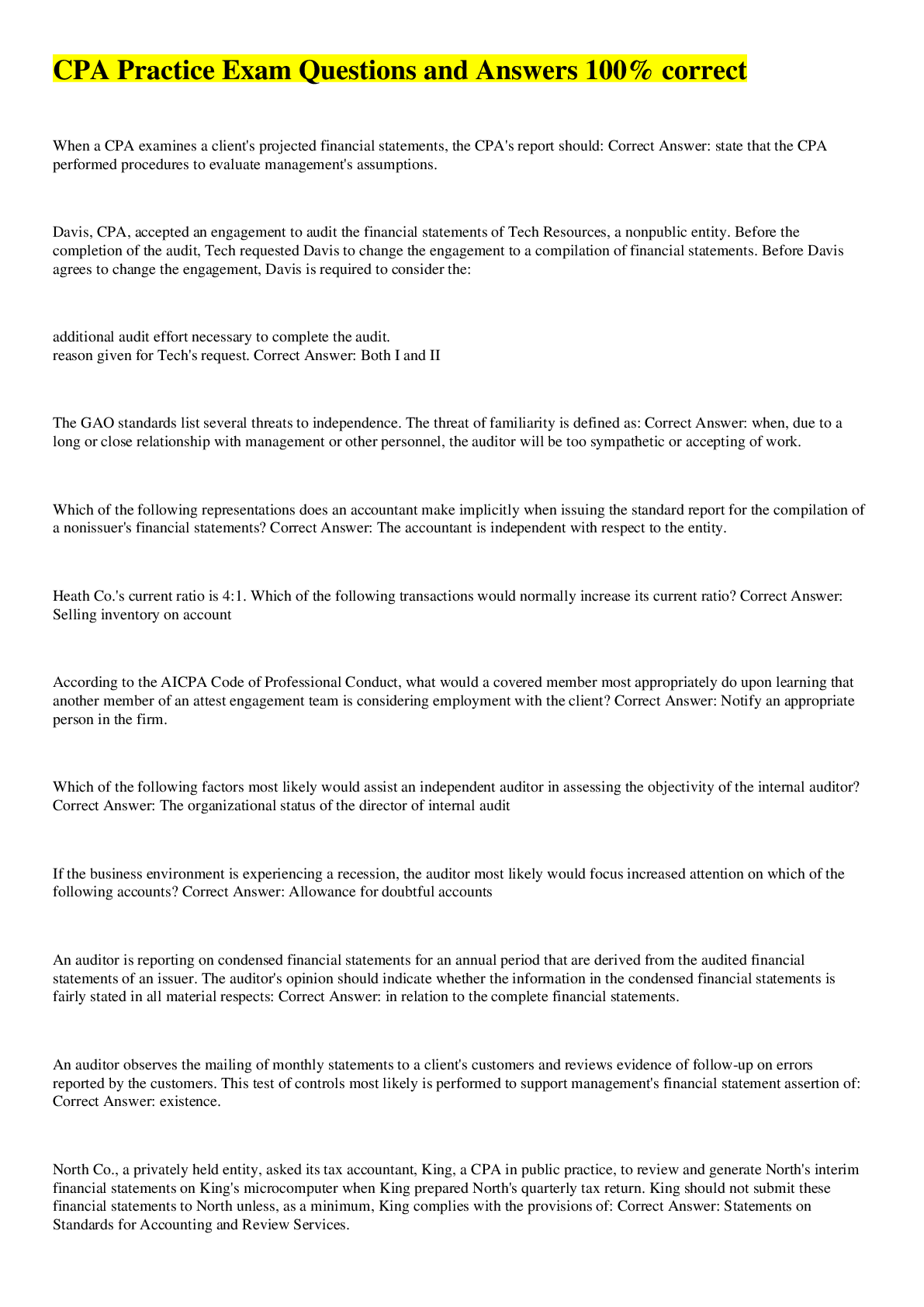
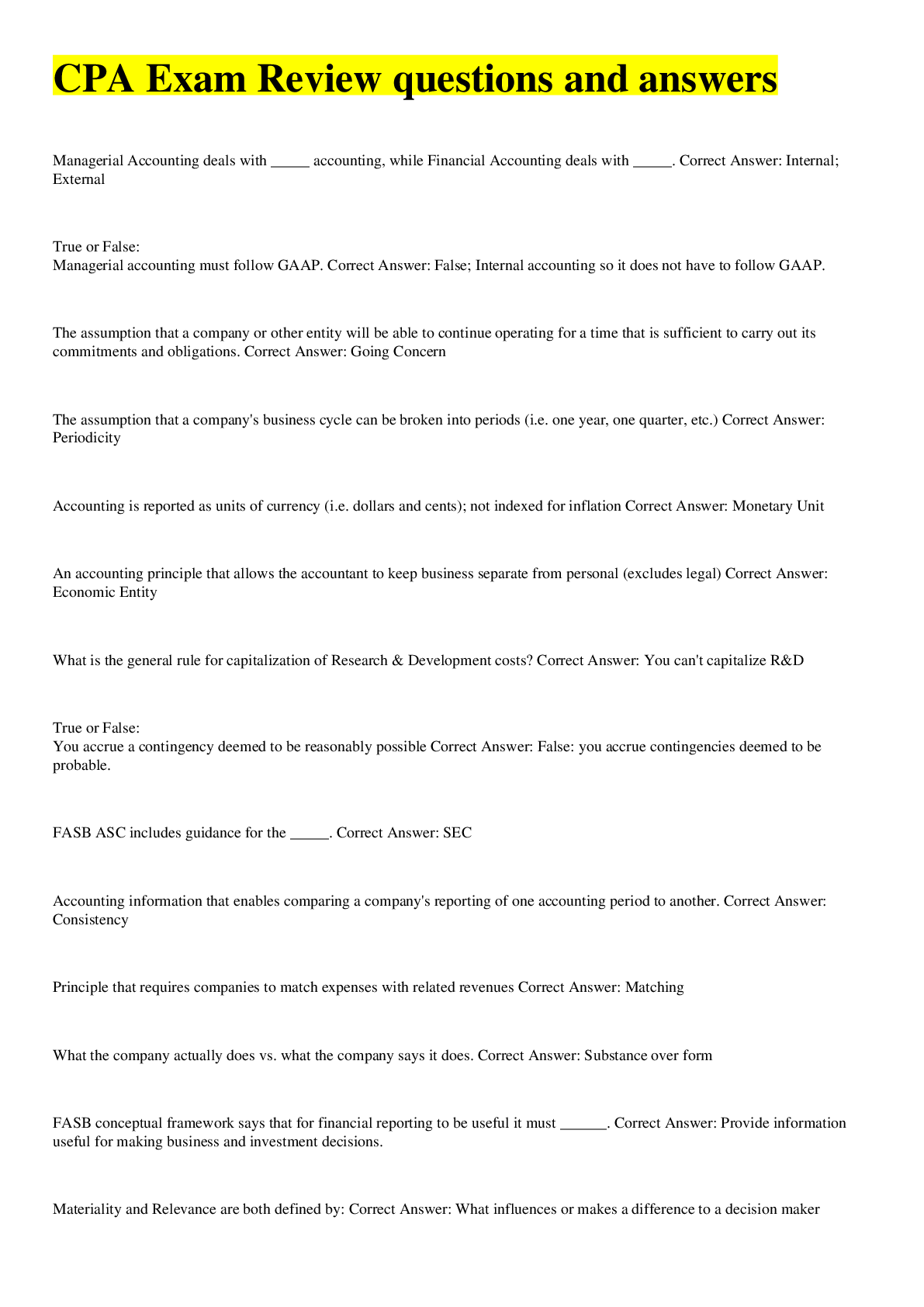


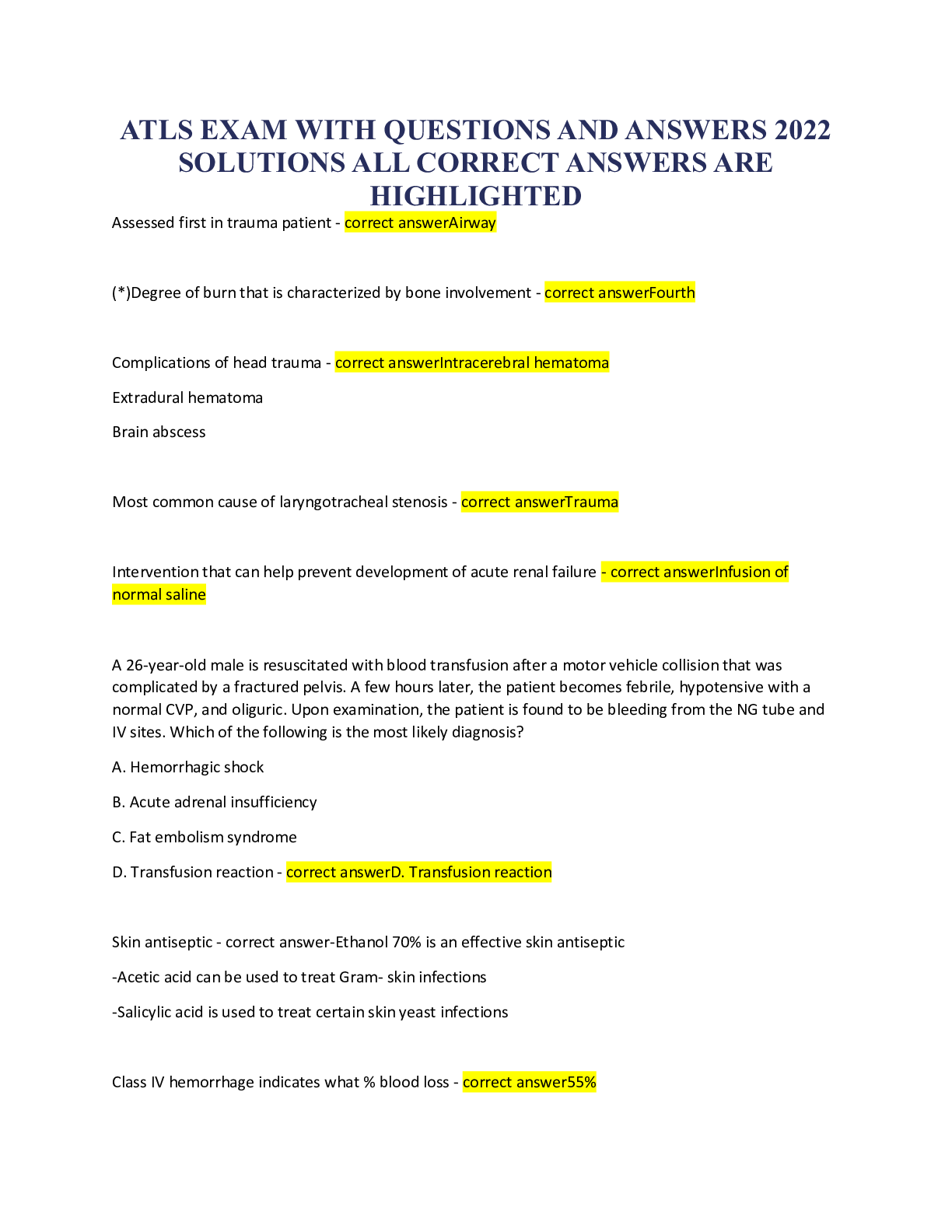

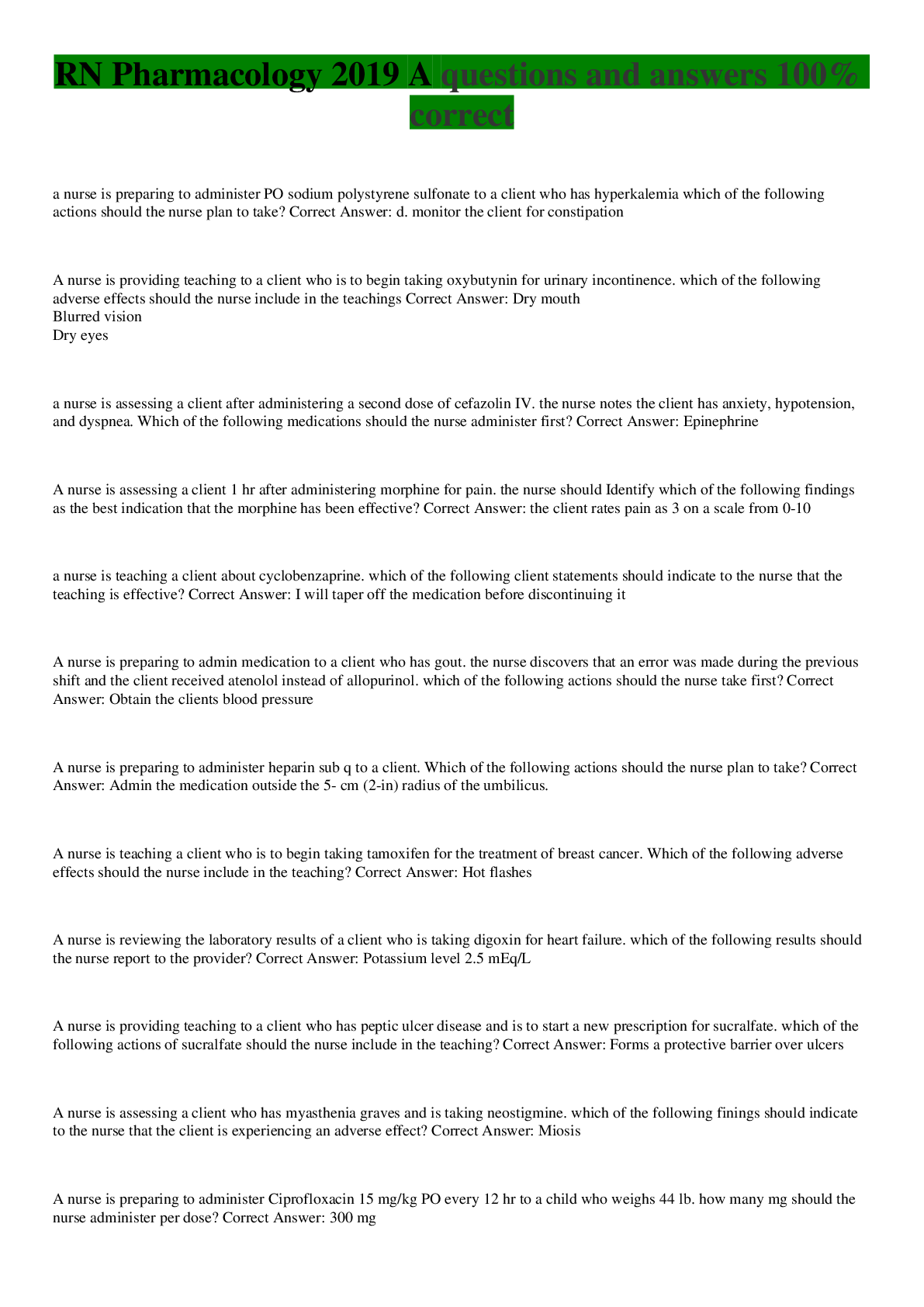
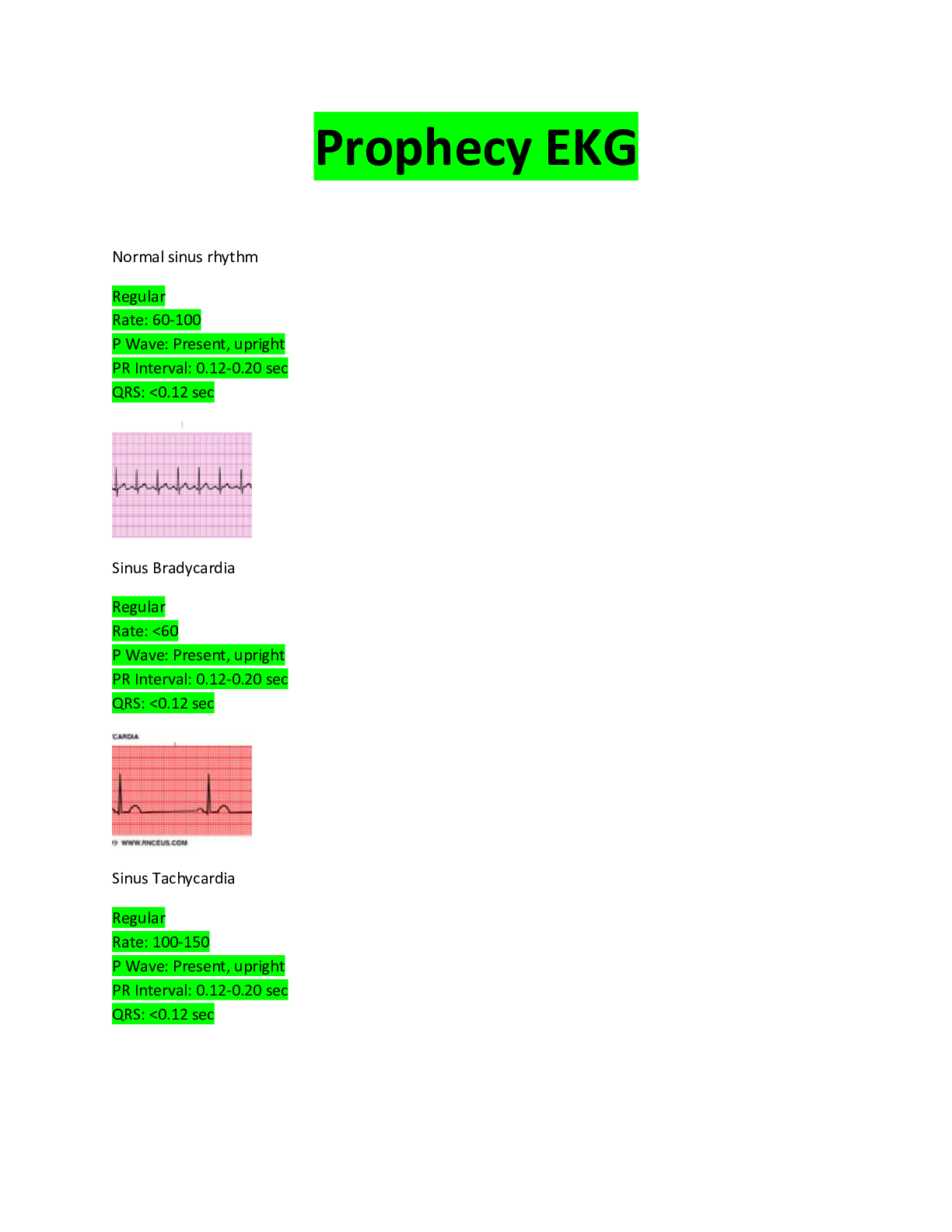
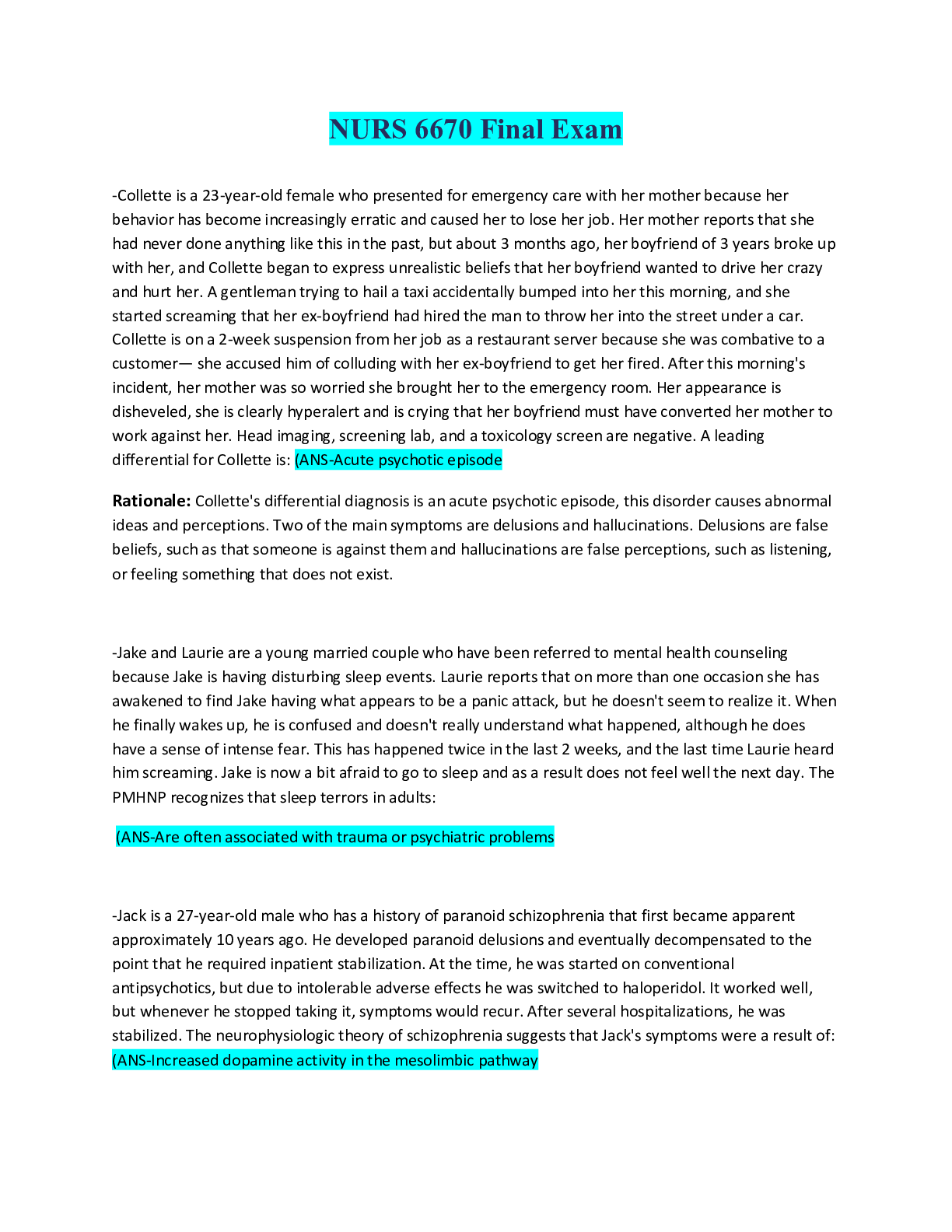
 University of Phoenix.png)
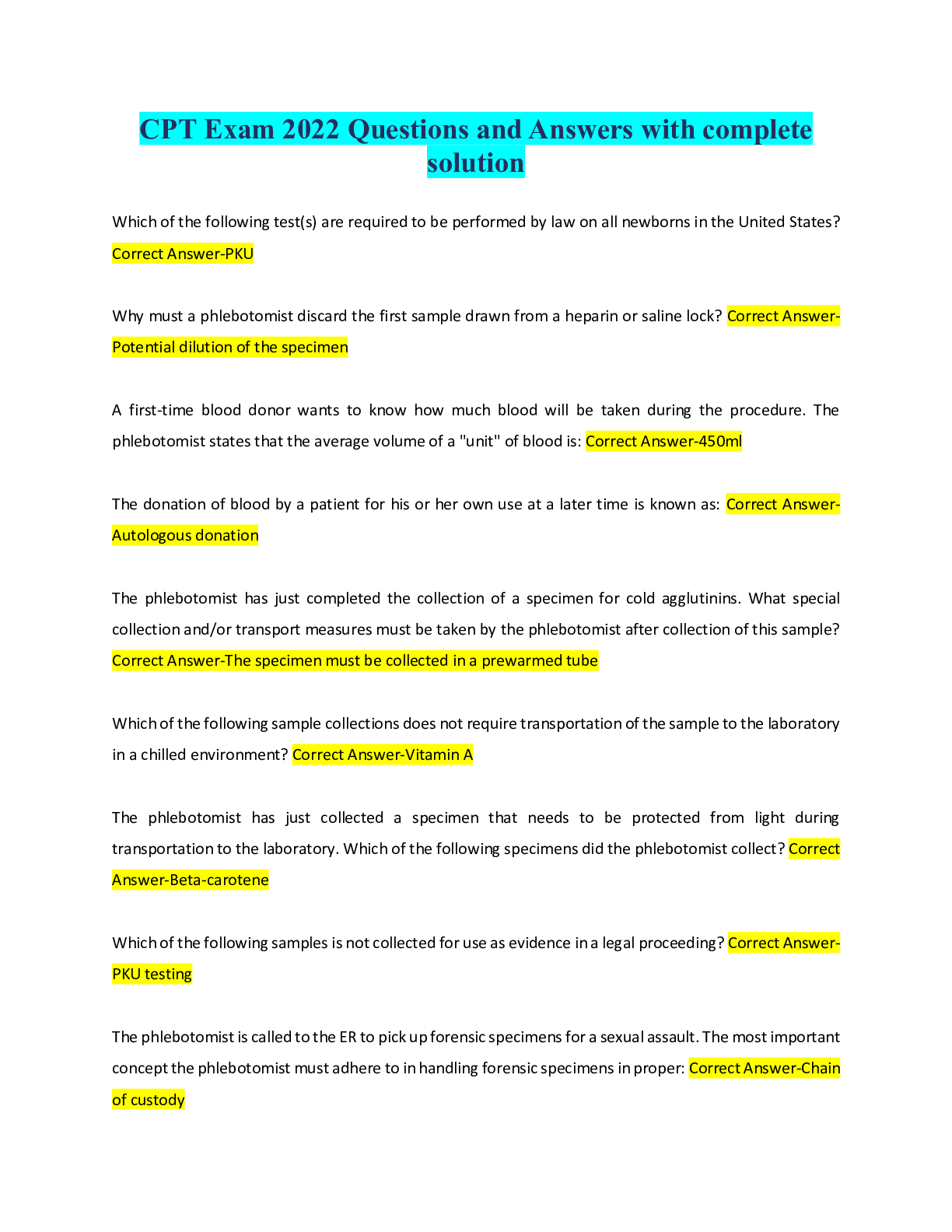
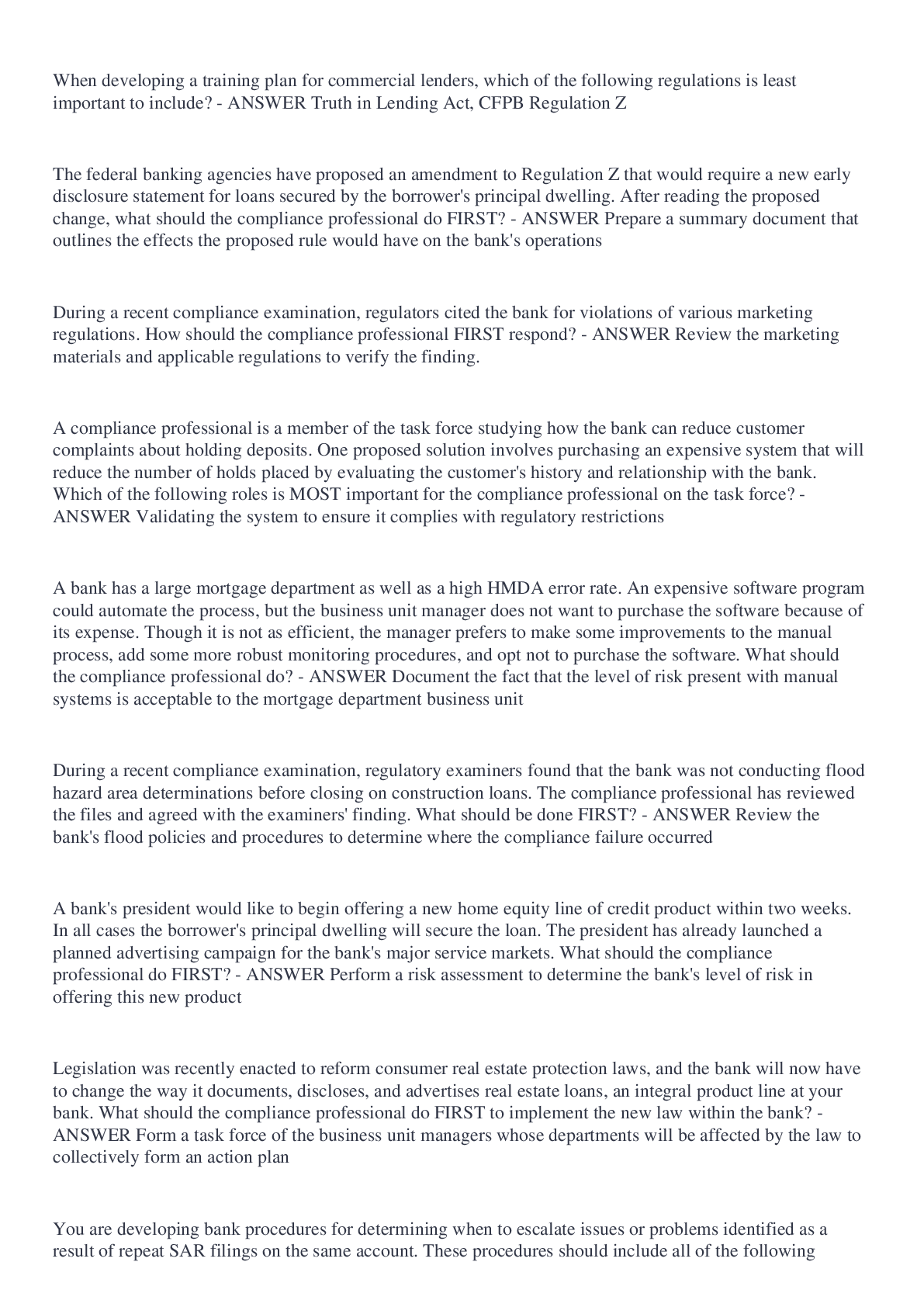


 Exam 2022 Questions & Answers.png)

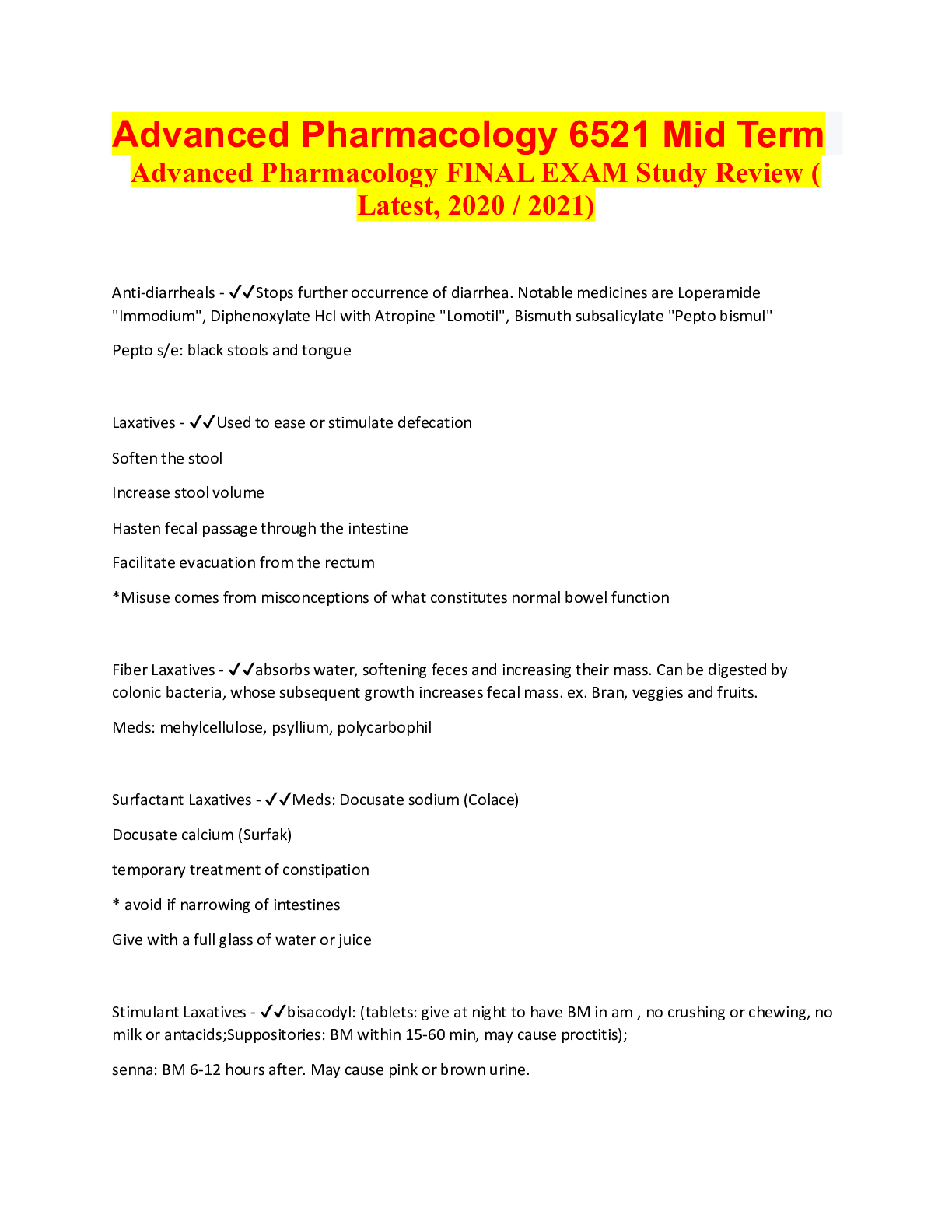
.png)


